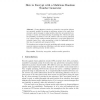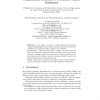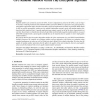130 search results - page 1 / 26 » How to Encrypt with a Malicious Random Number Generator |
FSE
2008
Springer
13 years 6 months ago
2008
Springer
Chosen-plaintext attacks on private-key encryption schemes are currently modeled by giving an adversary access to an oracle that encrypts a given message m using random coins that ...
CTRSA
2010
Springer
13 years 11 months ago
2010
Springer
Typical security models used for proving security of deployed cryptographic primitives do not allow adversaries to rewind or reset honest parties to an earlier state. Thus, it is c...
SACRYPT
1998
Springer
13 years 9 months ago
1998
Springer
In this paper, we present a simple method for generating random-based signatures when random number generators are either unavailable or of suspected quality (malicious or accident...
JUCS
2008
13 years 4 months ago
2008
Abstract: Recently, Au et al. [Au et al. 2007] pointed out a seemingly neglected security concern for certificateless public key encryption (CL-PKE) scheme, where a malicious key g...
EGH
2010
Springer
13 years 2 months ago
2010
Springer
Random numbers are extensively used on the GPU. As more computation is ported to the GPU, it can no longer be treated as rendering hardware alone. Random number generators (RNG) a...



